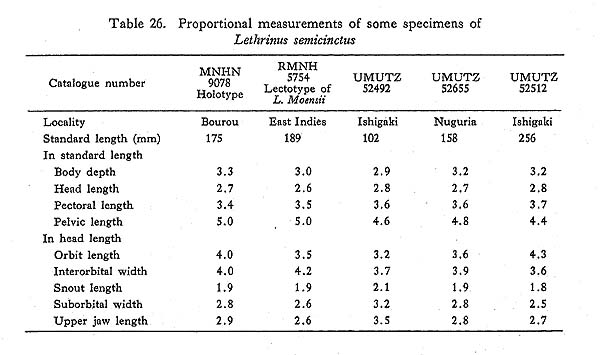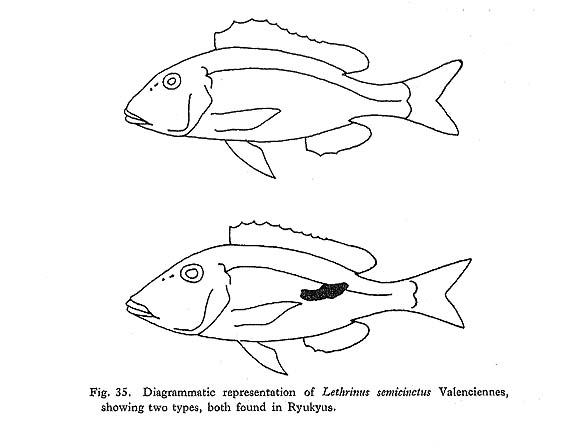V. DESCRIPTIONS
26. Lethrinus semicinctus Valenciennes
26. Lethrinus semicinctus Valenciennes |
 Plate 12 |
Lethrinus semicinctus Valenciennes in Cuvier & Valenciennes, 1830: 294, Bourou; Sauvage, 1875-91: 202, p1. 19, fig. 3, type.
Lethrinus sordidus Valenciennes in Cuvier & Valenciennes, 1830; 298, New Guinea.
Lethrinus Moensii Bleeker, 1855: 435, East Indies; 1873-76: p1. 297, type; 1876-77: 115,type.
Lethrinus reticulatus (not of Valenciennes); Shinohara, 1963: 42, fig. 3, Ryukyus; Sato, 1971: 140, fig. 14, Japan, Nuguria Atoll; Masuda et al., 1975: 59, fig. F, 234, southern Japan.
Specimens examined.
Holotype. —MNHN9078 (175 mm standard length) from Bourou.
Holotype of L. sordidus. —MNHN9091 (78.5) from New Guinea.
Lectotype of L. Moensii. —RMNH5754 (1 of 2 individuals: 189) from East Indies, here designated.
UMUTZ52492 (102), 52491 (108), 52490 (114), 52489 (127), 52523 (176), 52512 (256) from Ishigaki I., Ryukyus.
UMUTZ52446 (131), 52444 (131), 52443 (137), 52560 (145), 52655 (158) from Nuguria Atoll.
D. X, 9; A. III, 8; P1. 13; P2. I, 5; C. 8 + 7; L. lat. 46 to 49; Ltr. 5 or 6/i/14 or 15.
Proportional measurements of some specimens are shown in Table 26.

Head length more than body depth. End of jaws between the verticals through anterior and posterior nostrils. Interorbital area convex. Third to fifth dorsal spines longest. 5 scale rows between lateral line and median dorsal spines. Inner base of pectoral without scales. Lateral teeth of jaws conical.
Color. —Yellowish-brown, paler below. Fins reddish with brighter margin. A dark blotch of irregular shape above anal sometimes conspicuous, especially in young.
Distribution. —East Indies to Ryukyus, Bonins.
Remarks. —Though the specimen MNHN9078, collected by Quoy & Gaimard from Bourou, is without any indication as the type, the present writer believes it to be the holotype, because the specimen agrees completely with the original description which is based on a single specimen.
Of the two specimens of the Rijksmuseum van Natuurlijke Historie in Leiden labeled as the type of L. Moensii (RMNH5754), the smaller agrees well with the original description and the figure by the original author (Bleeker, 1873-76), and is here designated as the lectotype. The larger (238 mm standard length) belongs to a different species (L. ruhrioperculatus).
Figure 35 shows two variations of the body shape in the present species. It is likely that the present species is really a mixture of several species. More detailed study is necessary for this species.
